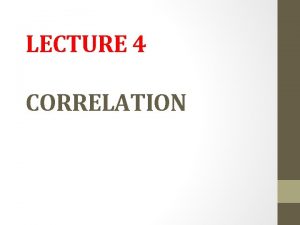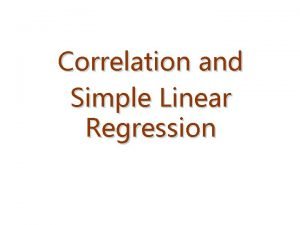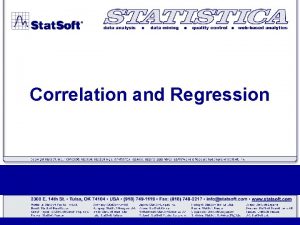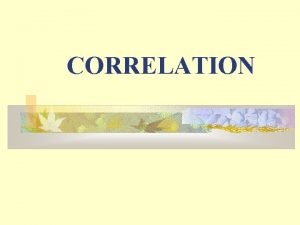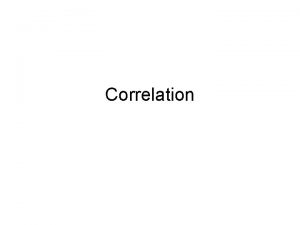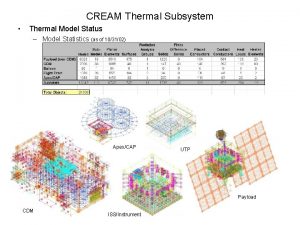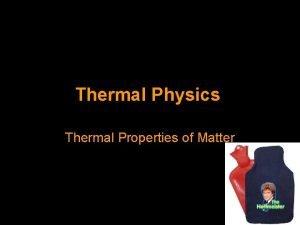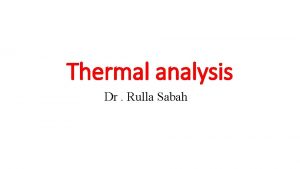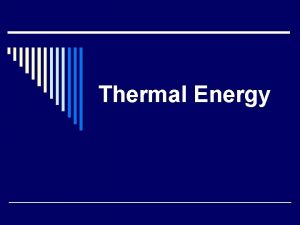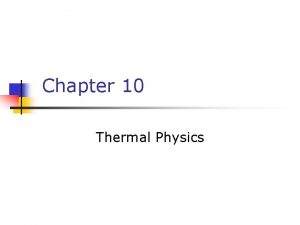Thermal Modeling and Model Correlation of the LORRI




































- Slides: 36

Thermal Modeling and Model Correlation of the LORRI Telescope Thomas C. Magee Johns Hopkins University Applied Physics Lab 443 -778 -8354 tom. magee@jhuapl. edu Tom Magee –LORRI Thermal Design - 1

Introduction • The LOng-Range Reconnaissance Imager (LORRI) is a telescope that was designed, fabricated, and qualified for the New Horizons Pluto mission. • LORRI was designed and fabricated by a combined effort of The Johns Hopkins University Applied Physics Laboratory and SSG Precision Optronics. • LORRI is a narrow angle (FOV=0. 29°), high resolution (IFOV = 5 rad), Ritchey-Chrétien telescope with a 20. 8 cm diameter primary mirror • Purpose of the telescope is detailed imaging of Pluto (flyby in 2015) Tom Magee –LORRI Thermal Design - 2

Artists Depiction of the New Horizons Spacecraft LORRI Radiator LORRI Telescope Aperture Tom Magee –LORRI Thermal Design - 3

View of LORRI Inside the Spacecraft Tom Magee –LORRI Thermal Design - 4

Thermal Challenges • Maintain focus without a focusing mechanism over a wide temperature range (-125ºC to 40ºC) – gradient from M 1 to M 2 must be less than 2. 5ºC – requires a low CTE material with high thermal conductivity • Maintain the CCD temperature below -70ºC while mounted deep inside a spacecraft which is at +40ºC – requires good thermal isolation Tom Magee –LORRI Thermal Design - 5

LORRI Mechanical/Thermal Concept Design MLI between Spacecraft Bulkhead and Telescope (not shown) MLI Covers Entire Outer K 13 Baffle High Thermal Conductivity Monolithic SSG Si. C Structure Flexible “S” Link Beryllium Conduction Bar Titanium Isolators (3) Beryllium Radiator MLI Rear Surface Magnesium Interior Baffles External G 10 Isolators K 13 C 2 U High Thermal Conductivity Baffle Shell with M 55 Baffle Blades Tom Magee –LORRI Thermal Design - 6

LORRI Mechanical Design (Outer Shell) Closest Point to Structure, 4 mm (. 160”) Clearance Invar Fittings Outer/Inner Flexure Connection (sandwiches composite) Outer Stiffening Ring T 300 Composite 1. 5 mm (. 06”) thk Purge Fitting Invar Fittings for Outer Mounts and E-Box Transfer Bonded to Both Outer Ring and Baffle Shell Tom Magee –LORRI Thermal Design - 7

CCD Mounting Detail CCD Mount Plate S-Link flexible thermal strap Beryllium Conduction Bar Titanium flexure (3 pls) provide thermal isolation and Titanium flexure (3 pls) limit load transmitted to telescope due to CTE mismatch “Thermabond” provides electrical isolation and thermal conduction Tom Magee –LORRI Thermal Design - 8

Radiator Connection Detail Decontamination Heaters Tom Magee –LORRI Thermal Design - 9

Thermal Blanket Design Concept 23 separate blankets Blankets not shown: • heat rod blanket • radiator blanket upper cylinder blanket conical closeout blanket cylinder closeout blanket lower cylinder blanket lower cap blanket foot tube blanket (6) foot base blanket (3) deck blanket FPU blanket Tom Magee –LORRI Thermal Design - 10

Summary of Thermal Design Features • • • Conductive Isolation – G 10 legs – Titanium Flexures – heater/sensor wires are bonded to the baffle tube Radiative Isolation – Thermal Blankets (15% of the total instrument mass) – Gold Coatings • back side of the M 2 support • radiator, conduction bar, CCD mounting plate • G 10 legs Thermally conductive optics metering structure – minimizes thermal gradients Thermally conductive Baffle Tube – provides a uniform radiative sink for the optics which helps minimize thermal gradients External Radiator – coupled to the CCD via a conduction bar and an S-Link thermal strap Tom Magee –LORRI Thermal Design - 11

LORRI Telescope in Mass Properties Fixture Radiator Mass properties measurement fixture Conduction Bar Telescope Baffle Tube Tom Magee –LORRI Thermal Design - 12

LORRI Telescope in Optical Test Fixture Tom Magee –LORRI Thermal Design - 13

LORRI Telescope Optics Tom Magee –LORRI Thermal Design - 14

Rear View of LORRI Telescope Conduction Bar S-Link Focal Plane Electronics Rigid-Flex CCD Harness M 1 Mirror Support CCD Mounting Plate Heater/Sensor wires are bonded to the baffle tube Tom Magee –LORRI Thermal Design - 15

Thermal Analysis Techniques • Finite Difference model is required – hand calculations using lump masses and conductors • finite element techniques create too many nodes to be compatible with ray trace modeling – execution in TAK (SINDA) • Radiation view factors are calculated between surfaces using a ray-tracing technique (TSS software) • FEA techniques were used to support the finite difference model for complex structures Tom Magee –LORRI Thermal Design - 16

Finite Difference Thermal Model • Thermal resistance network -lumped masses (nodes) -conductors • Most are calculated by hand • 380 nodes • 410 Linear Conductors • 14, 100 Radiation Conductors -generated by TSS (model representation) -goes as N 2/2 Tom Magee –LORRI Thermal Design - 17

Model Definition Node Definition Conductor Definition The user must keep track of all node numbers Tom Magee –LORRI Thermal Design - 18

Flight Interior and Exterior Radiation Model A separate model was used to model the radiator and the exterior of the spacecraft The node numbers in the radiation model must match the node numbers in the finite difference model Tom Magee –LORRI Thermal Design - 19

FEA Analyses to Support Finite Difference Analyses CCD Plate Flexure Telescope “squiggle” Isolator Radiator Foot CCD “Dogbone” Tom Magee –LORRI Thermal Design - 20

Predicted Temperatures vs E_star Tom Magee –LORRI Thermal Design - 21

LORRI Thermal Balance Test • The purpose of a thermal balance test is to simulate the flight conditions and to correlate thermal model • LORRI is mounted in a shroud that simulates the spacecraft interface (0ºC to 40ºC) • Flight blankets were installed • Chamber liner was flooded with LN 2 to simulate radiation to deep space • 5 separate test cases – a “good” model should correlate under varying conditions Tom Magee –LORRI Thermal Design - 22

Thermal Balance Test Fixture CAD model of shroud Photo of actual shroud Tom Magee –LORRI Thermal Design - 23

Thermal Blanket Installation Tom Magee –LORRI Thermal Design - 24

Thermal Shroud Photos Tom Magee –LORRI Thermal Design - 25

Thermal Balance Test Radiation Model Note: colors depict different optical properties Tom Magee –LORRI Thermal Design - 26

Thermal Balance Test Model (Hot Case) Telescope Temperature -61ºC Telescope Gradient -1. 4ºC CCD Temperature -82ºC Radiator Temperature -92ºC (cutaway view showing interior temperatures) (Degrees C) Tom Magee –LORRI Thermal Design - 27

LORRI Thermal Balance Test Data Break Vacuum Hot, Decontamination Heaters On Hot, Closed, Decontamination Heaters On Hot, Gradient Heater On Hot Open Cold Open Tom Magee –LORRI Thermal Design - 28

Comparison Between Test Results and Model Predictions Tom Magee –LORRI Thermal Design - 29

Comparison Between Test Results and Model Predictions Tom Magee –LORRI Thermal Design - 30

Modeling Error for the CCD Temperature Tom Magee –LORRI Thermal Design - 31

Modeling Error for the Telescope Temperature Tom Magee –LORRI Thermal Design - 32

Model Correlation Changes • Radiation Changes – adjust blanket effective emissivity to 0. 020 (0. 015 on the upper cylinder) – increase the aperture area by 5% • account for the fit of the blankets – increase the radiator area 10% • account for the edges – increase the emissivity of the mirror surfaces to 0. 85 • energy is focused • Conduction Changes – recalculate the conductance of the “squiggle” isolators based on FEA modeling results – adjust the effect length of the wires (heat leak from the wires) – increase the conductance in the baffle tube wall – increase the conductance from the baffle annuli to the main tube – increase the conductance of the telescope legs – increase the conductance from the CCD to the radiator Tom Magee –LORRI Thermal Design - 33

Gradient from M 1 to M 2 • Thermal Gradients in the optics structure in the balance test were less than predicted by the model – the in-flight thermal gradients will be comparable – The predicted gradients were less than the 2. 5 C requirement and the actual gradients should be less than predicted Actual Balance Test Gradient Predicted Gradient in the Balance Test Predicted Gradient in Flight -0. 6ºC -1. 3ºC -1. 1ºC Tom Magee –LORRI Thermal Design - 34

Optical Testing • Optical Testing at cold temperature was confirmed at the Goddard DGEF Tom Magee –LORRI Thermal Design - 35

Summary • A combination of modeling techniques was used to predict instrument temperatures – finite difference (overall model) • hand calculations (nodes and conductors) – finite element analysis (for complex structures) • used to support the finite difference model – ray-trace software (for radiation modeling) • A thermal balance test was performed to validate thermal model – slight changes were required to correlate the model in all 5 test cases • The flight version of the model was then updated with the same changes and revised flight predictions were made – the CCD should be colder than the requirement of -70ºC – The thermal gradient in the optics structure should be less than the requirement of 2. 5ºC • The LORRI telescope has been integrated with the New Horizons Spacecraft and is awaiting launch in 2006 for a 2015 flyby. Tom Magee –LORRI Thermal Design - 36
 Negative and positive correlation
Negative and positive correlation Positive correlation versus negative correlation
Positive correlation versus negative correlation Modeling and role modeling theory
Modeling and role modeling theory Relational modeling vs dimensional modeling
Relational modeling vs dimensional modeling Section 3 using heat worksheet answers
Section 3 using heat worksheet answers Thermal transfer vs direct thermal printing
Thermal transfer vs direct thermal printing Data modeling using entity relationship model
Data modeling using entity relationship model Data modeling using the entity relationship model
Data modeling using the entity relationship model Hát kết hợp bộ gõ cơ thể
Hát kết hợp bộ gõ cơ thể Ng-html
Ng-html Bổ thể
Bổ thể Tỉ lệ cơ thể trẻ em
Tỉ lệ cơ thể trẻ em Gấu đi như thế nào
Gấu đi như thế nào Tư thế worm breton
Tư thế worm breton Hát lên người ơi
Hát lên người ơi Môn thể thao bắt đầu bằng từ chạy
Môn thể thao bắt đầu bằng từ chạy Thế nào là hệ số cao nhất
Thế nào là hệ số cao nhất Các châu lục và đại dương trên thế giới
Các châu lục và đại dương trên thế giới Công thức tính thế năng
Công thức tính thế năng Trời xanh đây là của chúng ta thể thơ
Trời xanh đây là của chúng ta thể thơ Cách giải mật thư tọa độ
Cách giải mật thư tọa độ 101012 bằng
101012 bằng độ dài liên kết
độ dài liên kết Các châu lục và đại dương trên thế giới
Các châu lục và đại dương trên thế giới Thơ thất ngôn tứ tuyệt đường luật
Thơ thất ngôn tứ tuyệt đường luật Quá trình desamine hóa có thể tạo ra
Quá trình desamine hóa có thể tạo ra Một số thể thơ truyền thống
Một số thể thơ truyền thống Cái miệng bé xinh thế chỉ nói điều hay thôi
Cái miệng bé xinh thế chỉ nói điều hay thôi Vẽ hình chiếu vuông góc của vật thể sau
Vẽ hình chiếu vuông góc của vật thể sau Biện pháp chống mỏi cơ
Biện pháp chống mỏi cơ đặc điểm cơ thể của người tối cổ
đặc điểm cơ thể của người tối cổ Giọng cùng tên là
Giọng cùng tên là Vẽ hình chiếu đứng bằng cạnh của vật thể
Vẽ hình chiếu đứng bằng cạnh của vật thể Tia chieu sa te
Tia chieu sa te Thẻ vin
Thẻ vin đại từ thay thế
đại từ thay thế điện thế nghỉ
điện thế nghỉ





































